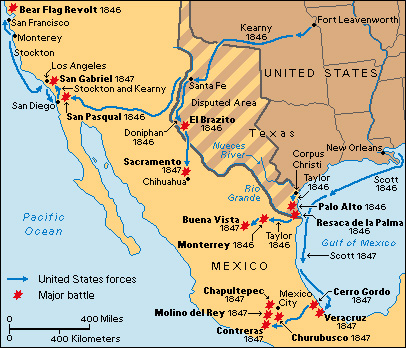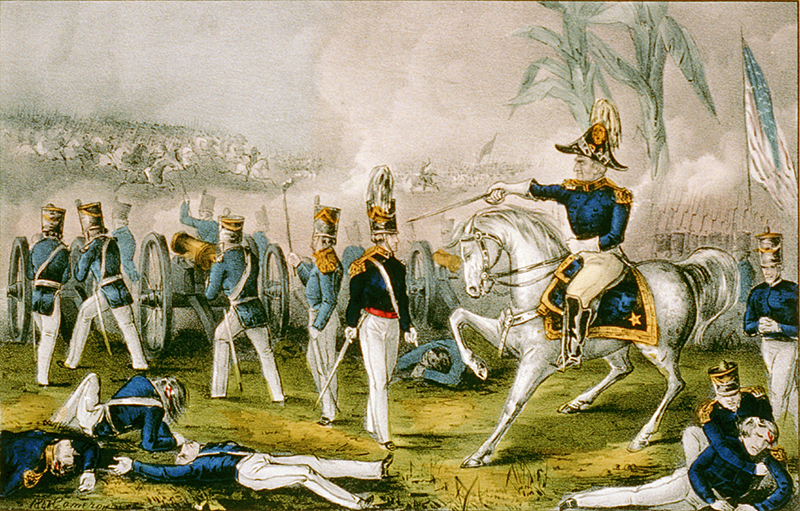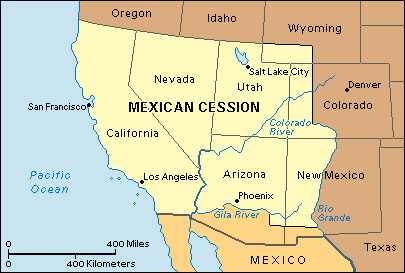Mexican War (1846-1848) was fought between the United States and Mexico over disagreements that had been accumulating for two decades. The war is also known as the U.S.-Mexican War or the Mexican-American War. In the course of the war, United States forces invaded Mexico and occupied the capital, Mexico City. By the Treaty of Guadalupe Hidalgo, the United States purchased from Mexico the regions of California, Nevada, and Utah, most of Arizona and New Mexico, and parts of Colorado and Wyoming. But many historians believe the war was an unnecessary attack on a weaker nation.
Causes of the war
Background of the war.
In 1835, Texas revolted against the Mexican government, which then controlled the region. Texans established the Republic of Texas in 1836, but Mexico refused to recognize Texas’s independence. The Mexican government warned the United States that if Texas were admitted to the Union, Mexico would go to war with the United States. James K. Polk was elected U.S. president in 1844. He favored the expansion of U.S. territory and supported the annexation of Texas. Texas was made a state in 1845, and Mexico broke off diplomatic relations with the United States. 
Other disputes existed between the two countries. One of these was the question of the boundary between Texas and Mexico. Texas claimed the Rio Grande as its southwestern border. Mexico said that Texas had never extended farther than the Nueces River. Also, Mexico owed U.S. citizens more than $3 million to make up for lives and property lost in Mexico since Mexico’s war for independence from Spain ended in 1821. By the 1840’s, many Americans demanded that the United States collect these debts by force.
There was also a growing feeling in the United States that the country had a “manifest destiny” to expand westward into new lands (see Manifest destiny ). The westward movement had brought Americans into Mexican territory, especially California. Mexico was too weak to control or populate its northern territories. Both American and Mexican inhabitants were discontented with Mexican rule. California seemed almost ready to declare itself independent.
Events leading up to the war.
In the fall of 1845, President Polk sent John Slidell to Mexico as American minister. Slidell was to offer Mexico $25 million and cancel all claims for damages if Mexico would accept the Rio Grande boundary and sell New Mexico and California to the United States. If Mexico refused to sell the territories, Slidell was to offer to cancel the claims on condition that Mexico agreed to the Rio Grande boundary. While Slidell was in Mexico, a new Mexican president came to power. Both the old and new presidents were afraid their enemies would denounce them as cowards if they made deals with the United States. They refused to see Slidell, who came home and told Polk that Mexico needed to be “chastised.”
Meanwhile, Polk had ordered Major General Zachary Taylor, who was stationed with about 4,000 men on the Nueces River, to advance to the Rio Grande. Taylor reached the river in April 1846. On April 25, a party of Mexican soldiers surprised and defeated a small group of American cavalry just north of the Rio Grande.
Polk had wanted to ask Congress to declare war on Mexico. The news of the battle gave him the chance to say that Mexico had “invaded our territory and shed American blood on American soil.” However, both Mexico and the United States claimed the soil where the blood was shed. On May 13, 1846, Congress declared war on Mexico.
The war
The Americans had two aims. They wanted to add to the United States the territory that Mexico had been asked to sell. They also wished to invade Mexico to force the Mexicans to accept the loss of the territory.
The occupation of New Mexico and California.
In June 1846, General Stephen W. Kearny set out with about 1,700 troops from Fort Leavenworth, Kansas, to capture New Mexico. In August, the expedition entered the New Mexican town of Santa Fe and took control of New Mexico. The next month, Kearny, with a small force, pushed across the desert to California.
Meanwhile, in June 1846, a group of American settlers in California revolted against the Mexican government. This rebellion became known as the Bear Flag Revolt because of the portrayal of a grizzly bear on the settlers’ flag. In July, U.S. naval forces under Commodore John D. Sloat captured the California town of Monterey and occupied the San Francisco area. On December 6, Kearny led about 100 troops in the bloody Battle of San Pasqual near San Diego. Reinforcements from San Diego helped save the small American army. In January 1847, U.S. troops under Kearny and Commodore Robert F. Stockton of the Navy won the Battle of San Gabriel near Los Angeles. This victory completed the American conquest of California.
Taylor’s campaign.
Before war officially began, General Zachary Taylor had driven the Mexicans across the lower Rio Grande to Matamoros in the two battles of Palo Alto and Resaca de la Palma. Mexican General Mariano Arista had led his force to capture Taylor’s supply base by besieging the small American garrison at what is today Brownsville, Texas. Taylor hurried to the rescue. Arista moved to block him at Palo Alto, where the opposing forces fought a battle on May 8, 1846. Taylor’s 2,300 U.S. troops defeated Arista’s 3,400 Mexicans.
Arista retreated closer to Brownsville and fought Taylor the next day, May 9. In the Battle of Resaca de la Palma, Taylor’s army crushed 5,000 soldiers under Arista. Taylor’s two victories allowed him to save the garrison at Brownsville and restore his supply line to the coast.
On May 18, Taylor crossed the Rio Grande and occupied Matamoros. After waiting for new troops, he moved his army up the river and marched against the important city of Monterrey. Monterrey fell on September 24, after a hard-fought battle. Before the end of the year, Taylor had occupied Saltillo and Victoria, important towns of northeastern Mexico. However, Mexico still refused to negotiate with the United States.
Polk and his advisers decided to land an army at Veracruz, on the east coast, and march to Mexico City. Many of Taylor’s best troops were ordered to join Major General Winfield Scott, who was placed in charge of the new campaign. President Antonio López de Santa Anna of Mexico commanded the Mexican Army. He learned of the American plans and immediately led a large army against Taylor at Buena Vista, in the mountains beyond Saltillo. Near the hacienda of Buena Vista, Taylor’s force of about 4,600 men defended a narrow mountain pass against Santa Anna’s army of about 15,000 men. In this battle, fought on Feb. 22 and 23, 1847, the Mexican forces nearly overran the U.S. positions, but Taylor’s troops eventually defeated them. General Taylor became a hero because of his victories and was elected president of the United States in 1848.

Doniphan’s victories.
In December 1846, Colonel Alexander W. Doniphan led about 850 troops south from Santa Fe to capture the Mexican city of Chihuahua. The American troops defeated a Mexican army at El Brazito on December 25 (Christmas Day). Doniphan’s army won the furious Battle of the Sacramento, fought just outside Chihuahua on Feb. 28, 1847. The Americans occupied the city on March 1.
Scott’s campaign.
General Scott was at this time the officer of highest rank in the United States Army. With a force of about 10,000 men, he landed near Veracruz on March 9, 1847. Twenty days later, he captured the city, and on April 8, he began his advance toward the Mexican capital. About 60 miles (97 kilometers) northwest of Veracruz, Santa Anna, with 13,000 troops, blocked Scott’s path at the mountain pass of Cerro Gordo, near Xalapa. On April 17 and 18, Scott’s 9,000-man force attacked the Mexicans and forced them to flee. The battle cleared the way to Mexico City.
In the small village of Churubusco, 6 miles (10 kilometers) south of Mexico City, Scott’s invading army won another major victory on Aug. 20, 1847. Scott’s soldiers stormed the fortified camp of Contreras, then attacked the Mexican force at Churubusco. The Mexicans finally fled and sought refuge within the walls of the capital city. The Americans had about 9,000 men in the battle. The Mexicans had about 30,000.
After Churubusco, Scott agreed to an armistice in hopes the Mexicans would negotiate. It soon became clear that they would not. Instead, Santa Anna violated the terms of the armistice to strengthen his forces. After two weeks of fruitless waiting, Scott resumed his advance. The Americans won a bloody battle at Molino del Rey. Then they faced the hilltop fortress of Chapultepec, which guarded the gates of Mexico City.
On Sept. 12, 1847, Scott’s cannon began to bombard Chapultepec, and the next day his infantry stormed the castle. As U.S. troops raised the Stars and Stripes over Chapultepec, most of the Mexican defenders retreated into Mexico City. U.S. troops followed. They attacked two of the city gates and forced their way past both of them. Overnight, Santa Anna withdrew his remaining troops from Mexico City. On the morning of September 14, the municipal authorities surrendered the city to Scott, whose troops then marched into the Mexican capital.
The peace treaty.
Despite all the American victories, Mexico refused to negotiate a peace treaty. In April 1847, Polk had sent Nicholas P. Trist, Chief Clerk of the Department of State, to join Scott’s army in Mexico and attempt to open diplomatic negotiations with Santa Anna. When the armistice of August failed, the president recalled Trist. But Santa Anna resigned shortly after Scott entered the Mexican capital. Mexico established a new government, and it feared that it might lose even more territory if it did not accept the American demands. At the request of the Mexican leaders and General Scott, Trist agreed to remain in Mexico against Polk’s orders and negotiate a settlement. 
The treaty was signed on Feb. 2, 1848, at the village of Guadalupe Hidalgo, near Mexico City. By this time, many people in the United States wanted to annex all Mexico. But the treaty required Mexico to give up only the territory Polk had originally asked for. The United States paid Mexico $15 million for the land, which became known as the Mexican Cession. The United States also took responsibility for paying $3 million in damage claims made by American citizens against Mexico. In 1853, the Gadsden Purchase gave an additional 29,640 square miles (76,767 square kilometers) to the United States (see Gadsden Purchase ).
Results of the war.
The United States gained more than 525,000 square miles (1,360,000 square kilometers) of territory as a result of the Mexican War. But the war also revived the quarrels over slavery. Here was new territory. Was it to be slave or free? The Compromise of 1850 made California a free state and established the principle of “popular sovereignty” in the rest of the Mexican Cession. That meant letting the people of a territory decide whether it would be slave or free. However, popular sovereignty later led to bitter disagreement and became one of the underlying causes of the American Civil War (1861-1865). See Compromise of 1850 ; Popular sovereignty .
The Mexican War gave training to many officers who later fought in the Civil War. Civil War officers who also fought in the Mexican War included, on the Union side, Ulysses S. Grant, William T. Sherman, George B. McClellan, and George Gordon Meade; and on the Confederate side, Robert E. Lee and Stonewall Jackson. Jefferson Davis, who would become president of the Confederate States of America, also served in the Mexican War.
